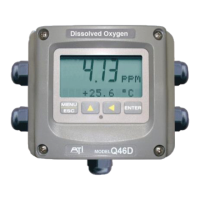3
O&M Manual
Rev-D (2/16)
Part 1 – Modbus Description
1.1 Modbus Technical Overview
Modbus protocol is a messaging structure, widely used to establish master-slave communication
between intelligent devices. A message sent from a master to a slave contains a one-byte slave
address, a one-byte command, data bytes (depending on command), and a two byte CRC. The
protocol is independent of the underlying physical layer and is traditionally implemented using
RS232, RS422, or RS485 over a variety of media (e.g. fiber, radio, cellular, etc.).
The protocol comes in 2 flavors – ASCII and RTU. The formats of messages are identical in both
forms, except that the ASCII form transmits each byte of the message as two ASCII hexadecimal
characters. Therefore, ASCII messages are twice as long as RTU messages. The main
advantage of the RTU mode is that it achieves higher throughput, while the ASCII mode allows
time intervals of up to 1 second to occur between characters without causing an error. As stated
earlier, the transmitter uses the RTU form and does not support the ASCII form.
The basic structure of an RTU frame is shown below:
[ADDRESS][FUNCTION][DATA][CRC]
The address field of a message frame contains an eight-bit slave device address in the range of 0
... 247 decimal. The individual slave devices are assigned addresses in the range of 1 ... 247, and
address 0 is reserved as a broadcast address. A master addresses a slave by placing the slave
address in the address field of the message. When the slave sends its response message, it
places its own address in this address field of the response to let the master know which slave is
responding. All slaves accept broadcast messages (address 0) as though they were addressed
specifically to them, but do not transmit a response message.
The function code field of a message frame contains an eight-bit code in the range of 1 ... 255
decimal. When a query message is sent from the master, the function code field tells the slave
device what kind of action to perform. Examples include reading the contents of a group of
registers, writing to a single register, writing to a group of registers, and reading the exception
status.
When the slave device responds to the master, it uses the function code field to indicate either a
normal (error-free) response or that some kind of error occurred (called an exception response).
For a normal response, the slave simply echoes the original function code. For an exception
response, the slave returns a code that is equivalent to the original function code with its most
significant bit set to logic 1.
The data field is constructed of one or more bytes and contains additional information, which the
slave must use to take the action defined by the function code. This can include items like
discrete and register addresses, the quantity of items to be handled, and the count of actual data
bytes in the field.
If no error occurs, the data field of a response from a slave to a master contains the data
requested. If an error occurs, the field contains an exception code that the master application can
use to determine the next action to be taken.

